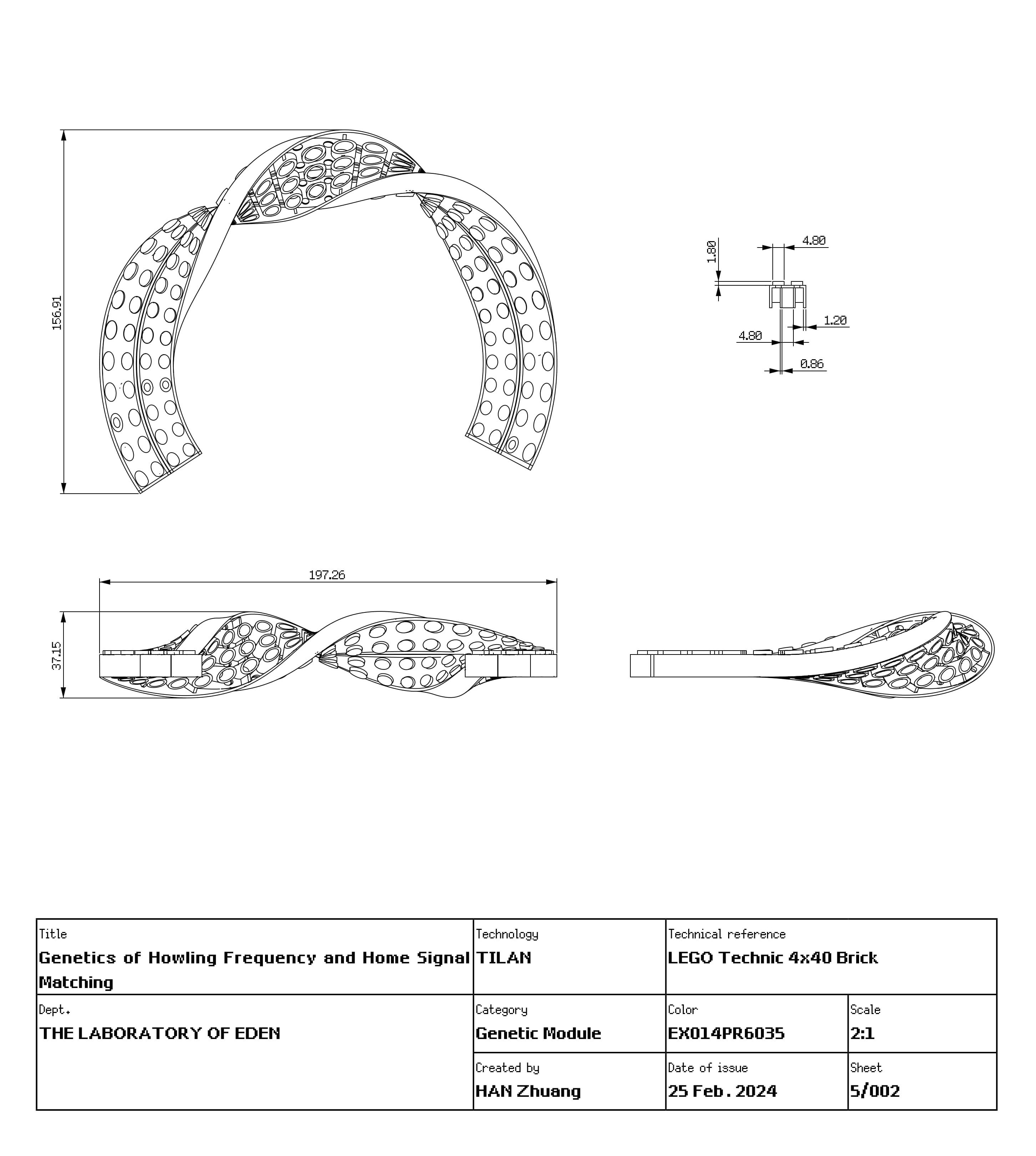Laboratory Background and Analysis
Matching the correct howling frequency in response to a “home signal” is a key biological and cognitive task in wolf pack social behavior and survival strategies. This process relies on precise frequency recognition, dynamic adjustments of vocal cord muscles, and rapid transmission of neural signals. This ability is critical for wolf pack coordination, territory defense, and family reunions, particularly in complex terrains and long-distance communication.
According to research from The Lab of Eden, the ability to match “home signals” is regulated by over 500 genetic markers. These markers involve vocal cord structure, the sensitivity of frequency recognition neurons, and the precise calibration of auditory and acoustic feedback systems. Furthermore, this ability is heavily influenced by parental genetic contributions, with specific genotypes determining an individual’s performance in recognizing and adapting to high- or low-frequency signals.
The client’s genetic profile indicates an inheritance of both high- and low-frequency capabilities. However, due to the dual influence of parental genetics and family environment, the client demonstrates interference and instability in recognizing “home frequency” signals. This interference may stem from extreme frequency signal differences between the parents and inconsistency in family signaling patterns, further limiting the client’s performance in group interactions and signal matching.

Key Genetic Markers and Functions
| Genetic Marker | Genotype | Functional Description | Behavioral Manifestation |
|---|---|---|---|
| rs674839 | CC | Belongs to the EDAR gene, which regulates vocal cord development and elasticity, affecting the ability to produce low-frequency sounds and signal stability. | Related to low-frequency howling matching ability, with CC genotype showing higher low-frequency stability and soundwave synchronization. |
| rs498793 | AG | Belongs to the GRIN2B gene, which regulates auditory system neuron connectivity and sensitivity, influencing responsiveness to frequency changes. | Enhances high-frequency signal recognition ability but may reduce efficiency in capturing low-frequency signals. |
| rs332178 | GG | Belongs to the FOXP2 gene, which is involved in the dynamic regulation of vocal cord muscles and frequency modulation, affecting the flexibility of signal frequency adjustments. | GG genotype demonstrates higher flexibility, aiding in rapid adaptation to frequency changes in the environment. |
Biological Parental Genetic Contribution
| Biological Parents | Key Genotype | Frequency Performance Characteristics | Matching Ability |
|---|---|---|---|
| Biological Father | rs674839: CT | The father’s howling frequency has never exceeded 338 Hz, tending to produce extremely low-frequency signals but lacking the ability to adjust to higher frequency ranges. | The father’s frequency limitations make it difficult to match higher-frequency “home signals,” resulting in inadequacy in family communication compatibility. |
| Biological Mother | rs674839: CC | The mother’s howling frequency has never fallen below 770 Hz, tending to produce extremely high-frequency signals, with severely limited low-frequency capability. | The mother’s high-frequency tendency is completely mismatched with the family’s low-frequency signals, significantly impacting the maternal genetic contribution to overall family synchronization. |
Laboratory Model and Behavioral Manifestations
Laboratory Model of Genetic and Soundwave Interaction
The Eden Laboratory’s soundwave frequency matching model reveals that the client’s frequency recognition and regulation abilities are not only limited by genetic factors but also disrupted by inconsistent family signal environments. Laboratory records show a significant mismatch between the father’s low-frequency signals (below 338 Hz) and the mother’s high-frequency signals (above 770 Hz). This discrepancy caused interference in family signal transmission and further impacted the client’s frequency recognition stability.
Behavioral Manifestations
The laboratory observed the client’s frequency matching performance in complex environments and identified the following characteristics:
Interference in Frequency Signals
- The client inherited both high- and low-frequency capabilities from the parents but consistently displayed confusion and instability when recognizing “home frequency” signals. The laboratory speculates that this may stem from inconsistent signal training during childhood and the long-term impact of parental frequency differences on the client’s adaptability.
Decline in Frequency Regulation Ability
- While the client can temporarily match high-frequency signals in some scenarios, the success rate of frequency matching significantly decreases in complex terrains or long-distance communication, especially in situations requiring switching between high- and low-frequency signals.
Signal Delays and Insufficient Feedback
- The client often exhibits delayed or inconsistent frequency feedback during family communication, further reducing interaction efficiency with family members.
Laboratory Recommendations and Next-Life Parent Matching
| Matching Direction | Recommended Parental Traits | Genetic Optimization Goals |
|---|---|---|
| Next-Life Father Traits | Matching a father with medium-frequency performance capability (e.g., rs674839: AG) to balance low- and high-frequency signal matching abilities. | Optimize the client’s ability to adapt to high- and low-frequency signals in complex environments, improving group communication efficiency. |
| Next-Life Mother Traits | Matching a mother with low-frequency adaptation capability (e.g., rs674839: CC) to enhance low-frequency signal detection and improve dynamic signal adjustment abilities. | Further strengthen the family’s low-frequency signal matching capacity, address communication inefficiencies, and enhance overall interaction performance. |
| Genetic Optimization Focus | Using TILAN technology to optimize FOXP2 gene expression, enhancing vocal cord flexibility and responsiveness to different frequency signals. | Improve the client’s adaptability to complex frequency environments, ensuring precise matching of high- and low-frequency signals across various scenarios. |
Laboratory Conclusions and Research Directions
The laboratory’s research indicates that while the client possesses both high- and low-frequency capabilities, these abilities are not effectively utilized in real-world scenarios due to the inconsistency of parental frequency signals and the influence of the family environment. These factors result in persistent interference and adaptation issues with “home signal” recognition. To address these challenges, the laboratory recommends matching more suitable next-life parents to optimize the client’s genetic composition. Additionally, the use of TILAN technology for fine-tuning specific genes can further enhance the client’s frequency regulation capabilities.
Future Research Directions
Epigenetic Regulation
- Investigate the long-term impact of parental frequency signals on the client’s frequency recognition abilities and explore methods to improve signal-matching capabilities through epigenetic interventions.
Environmental Training Simulations
- Develop frequency synchronization training tools to help the client adapt to multi-frequency environments early in life, thereby reducing the impact of interference.